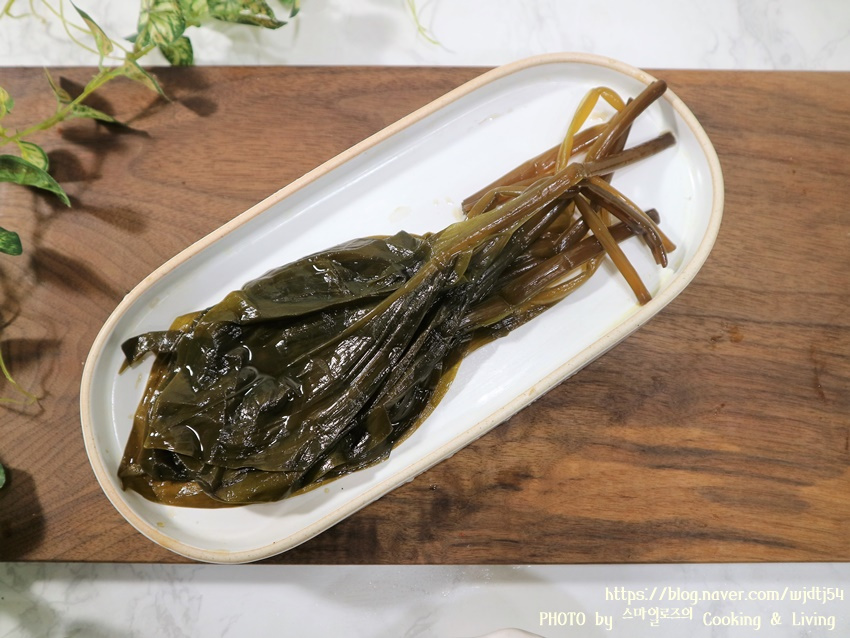Aromatic Pickled Myeonginamul
How to Make Delicious Pickled Myeonginamul with Seasonal Mountain Garlic

Discover the delightful taste of Myeonginamul, also known as mountain garlic, a prized delicacy that everyone loves. This recipe transforms the freshest seasonal Myeonginamul into a savory pickle, perfect for your table. While great as pickles, Myeonginamul also shines in kimchi or as a fresh wrap for grilled meats. Often served in small portions at Korean BBQ restaurants, these pickles evoke fond memories of delicious meals. Elevate your rice with a bite of this flavorful pickle – it’s so good, you’ll finish your rice in no time! Learn how to make this special side dish at home.
Main Ingredients- 1kg Myeonginamul (Korean wild garlic)
- A little baking soda (for washing)
Pickle Brine Ingredients- 3 cups Soy Sauce
- 2 cups Broth (or water)
- 1 cup Soju (or clear rice wine)
- 2 cups Sugar
- 2 cups Vinegar
Broth Ingredients (Optional, for added depth of flavor)- 1 dried pollack head
- A handful of dried radish strips
- 3-4 dried apple slices
- 1 white part of a leek
- 2-3 dried shiitake mushrooms
- 1 pack of anchovy/kelp broth pack (or dried anchovies, kelp)
- 3 cups Soy Sauce
- 2 cups Broth (or water)
- 1 cup Soju (or clear rice wine)
- 2 cups Sugar
- 2 cups Vinegar
Broth Ingredients (Optional, for added depth of flavor)- 1 dried pollack head
- A handful of dried radish strips
- 3-4 dried apple slices
- 1 white part of a leek
- 2-3 dried shiitake mushrooms
- 1 pack of anchovy/kelp broth pack (or dried anchovies, kelp)
Cooking Instructions
Step 1
Gently wash the Myeonginamul 3-4 times under running water to remove any dirt or debris. Fill a large bowl with enough water to submerge the Myeonginamul, add a little baking soda, and let it soak for about 10 minutes. This helps to effectively remove any residual pesticides or impurities. After soaking, drain the Myeonginamul and rinse again under running water. Gently shake off excess water or place it in a colander to drain thoroughly.

Step 2
Combine all the broth ingredients (dried pollack head, dried radish, dried apple slices, leek, shiitake mushrooms, broth pack, etc.) in a pot and cover with water. Bring to a boil over high heat for 10 minutes. Once boiling, reduce the heat to medium-low and simmer for another 10 minutes to extract a rich flavor. (I made a generous batch of broth last year and used it for other pickles, stews, and soups – it was incredibly useful!)

Step 3
Strain the broth, discarding the solids, to obtain a clear liquid. In a clean pot, combine the prepared broth, soy sauce, and sugar. Bring to a boil and stir until the sugar is completely dissolved. Turn off the heat, then add the vinegar and soju. Adding vinegar and soju after turning off the heat helps preserve their flavor and aroma, enhancing the taste of the pickles. (Adding them while the liquid is hot can cause the alcohol to evaporate and the vinegar’s acidity to become too strong.)

Step 4
It’s convenient to wash the Myeonginamul the evening before and let it drain, so you can pack it into containers the next morning. Carefully arrange the prepared Myeonginamul in a clean glass jar or airtight container. Avoid packing it too tightly; leave a little space.

Step 5
Allow the prepared pickling brine to cool down slightly. Pouring hot brine can soften the Myeonginamul’s crisp texture. Wait until it’s warm to the touch (around 50-60°C or 120-140°F) before pouring it over the Myeonginamul in the container.

Step 6
After pouring the brine, place a heavy plate or a weight on top of the Myeonginamul to keep it submerged. About a week after pickling, carefully drain the brine, bring it to a boil again, let it cool completely, and then pour it back into the container. This process deepens the flavor. Stored in the refrigerator, these pickled Myeonginamul will remain delicious for up to a year without spoiling. (If reusing the brine, always boil it and let it cool completely before re-adding to prevent spoilage.)

Step 7
I remember taking this photo just 2 days after pickling, driven by my impatience to taste it! Even then, a wonderful aroma was already filling the air.

Step 8
#MyeonginamulBenefits: Myeonginamul, uniquely known for its garlicky aroma among mountain vegetables, is also called ‘mountain garlic.’ It offers various health benefits, including boosting immunity, aiding digestion, preventing cardiovascular diseases and adult diseases, detoxifying the body, improving eye health, exhibiting anti-cancer properties, managing diabetes, and slowing down aging.

Step 9
These pickled Myeonginamul are the perfect accompaniment to grilled meats, offering a delightful contrast in texture and flavor! By making a batch during Myeonginamul season, you can enjoy delicious and satisfying meals with a readily available side dish for the entire year. They’re a true ‘rice thief’ when you’re not feeling particularly hungry!

Step 10
The photo on the left shows the pickles I made last year, and the one on the right shows them after a year. Interestingly, the flavor becomes richer and more delicious over time. They are at their absolute best right now!




